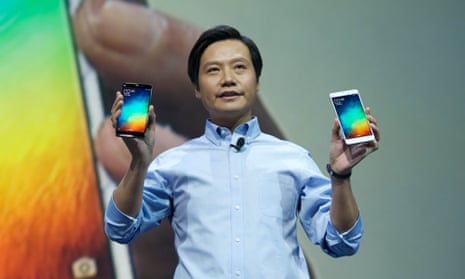Imitation continues to be the the most sincere form of flattery after Chinese smartphone maker Xiaomi borrowed from both Apple and Samsung in naming its new handsets.
The new Mi Note (à la Samsung) and Mi Note Pro phablets (a la iPhone 6 Plus) from the world’s third-largest smartphone maker have high-end specifications, 5.7in screens, metal construction and curved glass on their fronts and backs.
They form part of a bold plan by Xiaomi’s bullish chief executive Lei Jun to become the world’s top smartphone manufacturer, overtaking Apple and Samsung in the next five to 10 years.
Jun’s target for the Mi Note was clear: the iPhone 6 Plus, which was used in comparison shots during the unveiling, leading Jun to mock the camera lump on the back of the Apple device.
Now Lei Jun mocking the iPhone 6 Plus camera bump. pic.twitter.com/KwH8sICoDr
— Ben Thompson (@monkbent) January 15, 2015
The “Chinese Steve Jobs”, as Jun is commonly called, hit out at critics including Apple’s Jonathan Ive.
Jun boasted of the number of patents the Chinese company has filed and its level of innovation, going as as far as displaying a patent awarded for the camera on the Mi Note.
The camera, despite its sub-7mm thickness, is flush with the body of the phone and does not bulge beyond the case like cameras on Apple’s iPhone 6 and Samsung’s Galaxy smartphones.
In complete contrast to Apple, Samsung and most other major smartphone manufacturers, Xiaomi took the unusual move of specifically naming the manufacturers of the individual components within the new phablets.
‘The phone as the centre’
Jun made a big deal of how the Mi Note had a Sharp-made display, a Sony-made camera, a Philips two-tone flash and a Sony or LG-made battery. The move is an attempt to instil confidence in the device with potential customers outside China who may never have heard of Xiaomi, clearly targeting a western audience.
The Mi Note has a 5.7in full HD screen, a 13-megapixel camera and runs a forked version of Android, while the Mi Note Pro has Qualcomm’s latest 64-bit processor and a higher resolution 2K screen, similar to the Samsung Galaxy Note 4.
Following Samsung’s announcement that it was surging head-on into the Internet of Things and chief executive BK Yoon’s pledge to have every one of its products connected within five years, Jun laid out similar plans.
“We are going to connect all of the smart devices with the phone as the centre,” said Jun, also announcing a media streaming box that connects to a TV.
Xiaomi has struggled to sell its devices outside China, facing bans in the key emerging market of India due to challenges from Ericsson over patent infringement.
Despite Jun’s claims of Xiaomi’s innovation and new patents, it remains to be seen whether the Mi Note will face similar obstacles outside China.
Samsung declined to comment.
Apple to Xiaomi: being number one is easy to say, more difficult to do

Comments (…)
Sign in or create your Guardian account to join the discussion